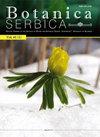A chemometric approach to the headspace sampled volatiles of selected Salvia species from Southeastern Serbia
IF 1.1
4区 生物学
Q4 PLANT SCIENCES
引用次数: 1
Abstract
Headspace sampling is a fast, simple and economical way to prepare plant samples for analysis by gas chromatography. For the first time, the composition of the head space volatiles (HSV) of six Salvia species (S. verticillata, S. glutinosa, S. nemorosa, S. aethiopis, S. amplexicaulis and S. officinalis) in the flowering stage and two (S. glutinosa and S. sclarea) in the fruiting stage from Southeastern Serbia was analysed using the GC-FID-MS technique after headspace sampling. The chemical composition of the highly volatile compounds of the analysed species varies considerably. Monoterpene hydrocarbons represented the dominant class of volatile compounds in all the Salvia species, except for S. sclarea and S. aethiopis. The content of sesquiterpenes was the highest in S. aethiopis (96.9%) and S. glutinosa in the flowering phase (29.5%), while in all the other samples that percentage was below 10%. Oxygenated monoterpenes were the most abundant in S. sclarea, where the main component was oxygenated monoterpene linalyl acetate (97.7%). The main component of S. verticillata was ?-phellandrene, and its content varied depending on the plant location and sampling time. The main component of S. glutinosa in the flowering phase was limonene (16.6%), and in the fruiting phase sabinene (87.1%). Headspace analysis of the volatile components of S. aethiopis was carried out for the first time and the most abundant detected components were sesquiterpenes: (E)- caryophyllene (36.8%), ?-copaene (33.4%) and ?-elemene (7.3%). The analysis of the principal components was performed to interpret the grouping patterns, as well as to analyse the similarities and differences between the samples in terms of the composition of the volatile components. The samples were grouped into three clusters. The first cluster consisted of samples of S. verticillata (S1, S4 and S5) from different locations, the second comprised samples of S. glutinosa (S3), S. aethiopis (S8), S. amplexicaulis (S9) and S. officinalis (S10), while samples of S. nemorosa (S7) made up the third cluster. The HS-GC-FID-MS technique can be successfully used for the qualitative and quantitative analysis of volatile compounds of different Salvia species. The obtained results are important for evaluating the possibility of using different types of sage.化学计量学方法对塞尔维亚东南部选定鼠尾草种的顶空取样挥发物进行分析
顶空取样是一种快速、简单、经济的制备植物样品的方法,用于气相色谱分析。采用气相色谱-红外光谱-质谱联用技术,首次对塞尔维亚东南部6种鼠尾草(S. verticillata, S. glutinosa, S. nemorosa, S. aethiopis, S. amplexicaulis和S. officinalis)开花期和2种鼠尾草(S. glutinosa和S. sclarea)的顶空挥发物(HSV)成分进行了分析。所分析物种的高挥发性化合物的化学成分差别很大。在所有鼠尾草品种中,单萜类化合物为挥发性化合物的优势类,除了ssclarea鼠尾草和saethiopis鼠尾草。倍半萜类化合物的含量以开花期的埃塞俄比亚葡萄(96.9%)和谷氨酸葡萄(29.5%)最高,其余样品均低于10%。其中含氧单萜含量最多,主要成分为芳樟酸单萜(97.7%)。黄花参的主要成分为?-香菜烯,其含量随植株位置和采样时间的不同而不同。开花期主要成分为柠檬烯(16.6%),果期主要成分为沙宾烯(87.1%)。首次对埃塞俄比亚梭菌的挥发性成分进行顶空分析,丰度最高的是倍半萜类成分:(E)-石竹烯(36.8%)、-copaene(33.4%)和-榄香烯(7.3%)。主成分的分析是为了解释分组模式,以及分析样品之间在挥发性成分组成方面的相似性和差异性。这些样本被分成三组。第一个聚类由不同地点的轮状棘球绦虫(S1、S4和S5)组成,第二个聚类由谷氨酸棘球绦虫(S3)、埃塞俄比亚棘球绦虫(S8)、扩增棘球绦虫(S9)和officinalis (S10)组成,第三个聚类由线虫棘球绦虫(S7)组成。HS-GC-FID-MS技术可用于不同鼠尾草品种挥发性成分的定性和定量分析。所得结果对评价使用不同类型鼠尾草的可能性具有重要意义。
本文章由计算机程序翻译,如有差异,请以英文原文为准。
求助全文
约1分钟内获得全文
求助全文
来源期刊

Botanica Serbica
Agricultural and Biological Sciences-Plant Science
CiteScore
1.40
自引率
12.50%
发文量
17
审稿时长
34 weeks
期刊介绍:
Botanica Serbica publishes original research papers on all aspects of plant, fungal and microbial biology research including the disciplines of microbiology, mycology, lichenology, bryology, flora, vegetation, biogeography, systematics, taxonomy, plant biotechnology, plant cell biology, plant ecology, environmental plant biology, forestry, genomics, horticulture, limnology, metabolomics, molecular biology, proteomics, virology, plant conservation and protection, and wildlife and ecosystem management.
 求助内容:
求助内容: 应助结果提醒方式:
应助结果提醒方式:


